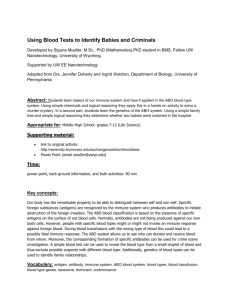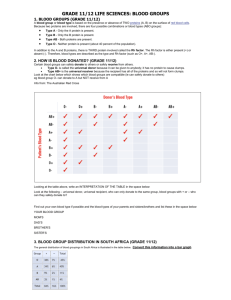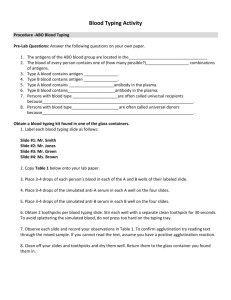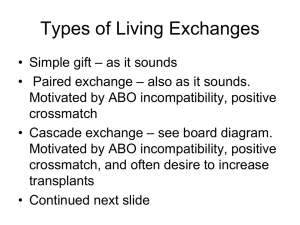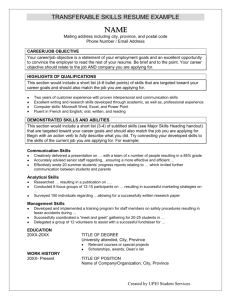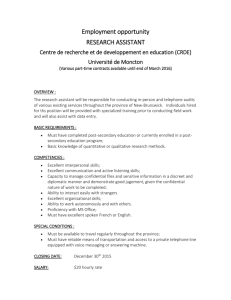Normal distribution of ABO blood group and Rhesus factor in Al
advertisement
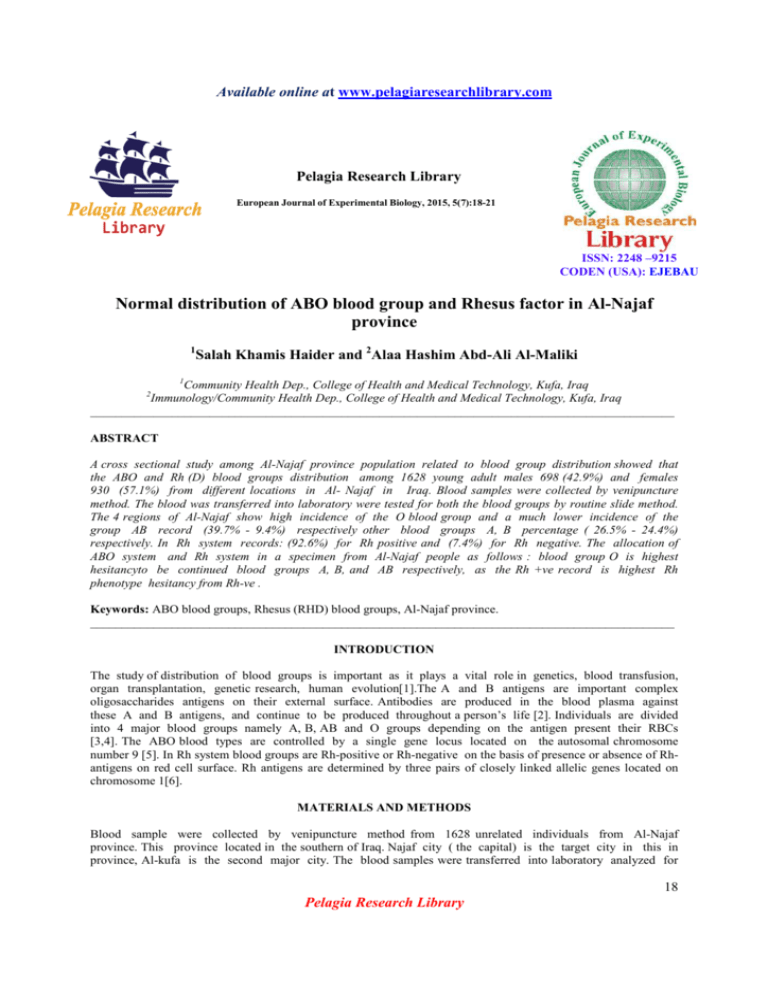
Available online at www.pelagiaresearchlibrary.com Pelagia Research Library European Journal of Experimental Biology, 2015, 5(7):18-21 ISSN: 2248 –9215 CODEN (USA): EJEBAU Normal distribution of ABO blood group and Rhesus factor in Al-Najaf province 1 Salah Khamis Haider and 2Alaa Hashim Abd-Ali Al-Maliki 1 Community Health Dep., College of Health and Medical Technology, Kufa, Iraq Immunology/Community Health Dep., College of Health and Medical Technology, Kufa, Iraq _____________________________________________________________________________________________ 2 ABSTRACT A cross sectional study among Al-Najaf province population related to blood group distribution showed that the ABO and Rh (D) blood groups distribution among 1628 young adult males 698 (42.9%) and females 930 (57.1%) from different locations in Al- Najaf in Iraq. Blood samples were collected by venipuncture method. The blood was transferred into laboratory were tested for both the blood groups by routine slide method. The 4 regions of Al-Najaf show high incidence of the O blood group and a much lower incidence of the group AB record (39.7% - 9.4%) respectively other blood groups A, B percentage ( 26.5% - 24.4%) respectively. In Rh system records: (92.6%) for Rh positive and (7.4%) for Rh negative. The allocation of ABO system and Rh system in a specimen from Al-Najaf people as follows : blood group O is highest hesitancyto be continued blood groups A, B, and AB respectively, as the Rh +ve record is highest Rh phenotype hesitancy from Rh-ve . Keywords: ABO blood groups, Rhesus (RHD) blood groups, Al-Najaf province. _____________________________________________________________________________________________ INTRODUCTION The study of distribution of blood groups is important as it plays a vital role in genetics, blood transfusion, organ transplantation, genetic research, human evolution[1].The A and B antigens are important complex oligosaccharides antigens on their external surface. Antibodies are produced in the blood plasma against these A and B antigens, and continue to be produced throughout a person’s life [2]. Individuals are divided into 4 major blood groups namely A, B, AB and O groups depending on the antigen present their RBCs [3,4]. The ABO blood types are controlled by a single gene locus located on the autosomal chromosome number 9 [5]. In Rh system blood groups are Rh-positive or Rh-negative on the basis of presence or absence of Rhantigens on red cell surface. Rh antigens are determined by three pairs of closely linked allelic genes located on chromosome 1[6]. MATERIALS AND METHODS Blood sample were collected by venipuncture method from 1628 unrelated individuals from Al-Najaf province. This province located in the southern of Iraq. Najaf city ( the capital) is the target city in this in province, Al-kufa is the second major city. The blood samples were transferred into laboratory analyzed for 18 Pelagia Research Library Salah Khamis Haider and Alaa Hashim Abd-Ali Al-Maliki Euro. J. Exp. Bio., 2015, 5(7):18-21 _____________________________________________________________________________ the anti-A, anti-B, and anti-D monoclonal antiserum (Spinreact) were used for blood group by slide method that placed on a clean white tile in three places. A drop of each of the antisera, anti A, anti B, anti D were mixed with each drop of blood. Blood groups were determined on the basis of agglutination.If agglutination is occurred that means it is positive, and if not it is a negative. Statistical analysis: The data were statistically calculated, using SPSS, version (17.0) and used Chi – square (P< 0.05) [8]. RESULTS Our results showed that the blood group O is the predominant 39.7% followed by blood group A 26.5%, blood group B 24.4% and blood group AB 9.4% . Male are predominant to female for blood group: O = 44.4% and 36.1% female are predominant to male in other blood groups as follow a group 28.5% and 23.6%; B group 25.6% and 22.9%; AB group 9.8% and 8.9% respectively (table 1). Table (1): Frequency of ABO blood groups in Al-Najaf province Blood Groups AB A B O Total Male % 62 (8.9) 166 (23.8) 160 (22.9) 310 (44.4) 698 (100) Female % 91 (9.8) 265 (28.5) 238 (25.6) 336 (36.1) 930 (100) Total % 153(9.4) 431 (26.5) 398 (24.4) 646 (39.7) 1628 (100) Frequency of Rh- positive is a bit higher in blood group O 39.7% more than other blood groups, Among the blood group O, it was observed that Rh D negative is nearly similar to Rh D positive. Most of the patient (92.6%) were Rh D positive, and there was statistically significant association between blood group and Rh D status table (2). Table (2): Rh-factor in different ABO blood groups in Al-Najaf province Blood Groups AB A B O Total Rh D +ve% 143 (9.5) 404 (26.9) 361 (23.9) 599 (39.7) 1507 (92.6) Rh D -ve% 10 (8.3) 27 (22.3) 37 (30.6) 47 (38.8) 121 (7.4) Total % 153 (9.4) 431 (26.5) 398 (24.4) 646 (39.7) 1628 (100) Both Rh D positive and Rh D negative are higher in female than male (57.2% and 56.2%) respectively (table 3). Table (3): Distribution of Rh D of blood groups in Al-Najaf province according to gender Sex Male Female Total Rh D Positive% 645 (42.8) 862 (57.2) 1507 (100) Rh D Negative% 53 (43.8) 68 (56.2) 121 (100) Total% 698 (42.9) 930 (57.1) 1628 (100) The distribution of ABO and RHD blood groups in the geographical areas of Al-Najaf province in Iraq is presented in Table (4). In our study blood group O was found predominant (39.7%), followed by group A (26.5%), group B (24.4%) and group AB (9.4%). Thus, in ABO blood groups among the subjects of the four selected cities. The pattern observed was O ˃ A ˃ B ˃ AB;respectively RHD positive subjects (92.6%) were over 13 times more than RHD negative subjects(7.4%). A chi-square test (P˂ 0.001). 19 Pelagia Research Library Salah Khamis Haider and Alaa Hashim Abd-Ali Al-Maliki Euro. J. Exp. Bio., 2015, 5(7):18-21 _____________________________________________________________________________ Table (4): Distribution of ABO and Rh blood group in some zones in Al-Najaf RhD and % Rh Rh + 80 1113 6.70% 93.30 34 298 10.20% 89.80% 4 57 6.60% 93.40% 3 39 7.10% 92.90% 121 1507 7.40% 92.60% O+ 441 31 129 13 19 20 10 27.9 599 39.7 Blood groups and their % OAB+ AB- B+ B472 110 117 278 307 39.6 6 9.7 25.7 29 142 24 3 61 7 42.80 27 8.1 68 20.5 1 4 1 12 1 33.9 8.5 5 22 13 2 5 0 10 0 12 11.6 5 23.3 10 646 143 153 361 398 47 9.4 10 24.4 37 A+ A285 299 14 25 84 11 95 28.6 20 1 37.2 21 15 1 37.2 16 404 431 26.5 27 Zones No.observed Najaf 1193 Kufa 332 Mishkab 59 Manathera 43 Total 1628 Table (5): Comparison of frequency in percentage of blood groups and Rh-D in different studies with our results Rh-ve % 17 3.3 6 4 3.2 10.4 7.4 Rh+ve % 83 96.7 94 95.9 96.8 89.6 92.6 AB% 3 4 2.7 4.7 9.6 0.7 9.4 B% 8 29 16.7 23.7 23.2 23.72 24.4 A% 42 34 25.3 22.5 26.6 33.14 26.5 O% 47 32.5 55.3 48.9 40.6 37 39.7 Country Britain Nepal Nigeria Guinea Bangladesh Iran Present study DISCUSSION In this study the O blood group was the most predominant (39.7%) of the participants. And the blood group AB was the lowest (9.4%). Similar distribution pattern of ABO blood group, theOs was (39.8%) and AB was (7.3%) reported in Al-Jouf province of the Saudi Arabia[9]. Similarly, in Pakistan, the blood group O was the most common (35%), and blood group AB is (8%) [10].This study is conformity with the other precedent studies in southern and central parts of Iraq which stated phenotype O was the most hesitancy group and as group AB sign up the lowest percentage. Rh-D distribution also varies within any group of human population[11]. In this study, it was observed that blood group O Rh-D positive is the highest (36.8%) and AB Rh-D positive was (8.8%) table (1). In overall, the total percentage of Rh-D positive was (92.6%). This study is inagreement with previous study in Nigeria [12].So, similar pattern of distribution observed in other studies. In south India, in Nairobi, Nigeria, Lahore, and Ralwalpindi [13,14].In the same previous study. Now, we like to compare our result with that of other study in different countries. From MedLine literature search we found that study on blood grouping has been done in some other countries likeIndia, Iran, Guinea, Nigeria, Britain, Bangladesh, Nepal, [15,9,16,17,18,19]table(5). CONCLUSION The present study is original in that, it is the first comprehensive study that documented the distribution of ABO and RHD blood groups among cities of Al-Najaf province of the Iraq. The allocation of ABO system and Rh system in a specimen from Al-Najaf people as follows : blood group O is highest hesitancyto be continued blood groups A, B, and AB respectively, as the Rh +ve record is highest Rh phenotype hesitancy from Rh -ve. We further plan to study the association between ABO blood groups and chronic viral hepatitis and other diseases and also with fertility. Acknowledgement: I personally thank and acknowledge Mr. Malla Sudhakar, Asst Professor, Department of Biotechnology, Indian Academy Degree College, for his constant support in the technical writing. REFERENCES [1] Harvey, GK., and David, JA. ″ Mollison’s Blood transfusion in Clinical Medicine″ 11th Edition. Oxford: Blackwell Scientific Puplications,(2005). pp, 114, 163. [2] Watkins, WM. Transfus Med.(2001); 11: 243-265. 20 Pelagia Research Library Salah Khamis Haider and Alaa Hashim Abd-Ali Al-Maliki Euro. J. Exp. Bio., 2015, 5(7):18-21 _____________________________________________________________________________ [3] Conteras, M.; Lubenko, S. ″ Immunohaematology: Introduction In: Postgraduated Haematology″Hoffbrand, AV, Lewis SM and Tuddenhan EGD (Eds). 4th Edition, Arnold Publishers, London, UK,(2001): 11, 164-181. [4] Knowles, S., Poole, G. ″ Human Blood group systems. In: Practical transfusion medicine″ 1st Edition, Blackwell Publishing ltd., UK,(2002),pp, 72-93. [5] Wikipedia, The free encyclopedia.″ ABO blood group system ″(2009)htm.(http:/www.geneames. org/data/hghc-data.php? match=ABO). [6] Talukder , SI. MD. And Ruhini, K.D. Dinajpur Med. Col. J .2010; 3 (2):55- 58. [7] From Wikipedia, the free encyclopedia, “ Al-Najaf Province in Governorate of Iraq” (2013). [8] Wayne, w. Daniel, " Biostatistics basic concepts and Methodology for the Health Sciences" John Wiley and sons (Asia) Pte Ltd, 2010. [9] Eweidah, M. H.; Rahiman, S.; Ali, MD. H. and Al-Shamary, AB. M. D, Anthropologist, (2011).13(2):99-102. [10] Pramanik, T. and Pramanik, S. Eastern Mediterranean Health J. (2000); 6(1):156 – 158. [11] Hasan, A.M.; Saleemh, H.A.; Azhar, S.M.; and Haider, K.M. Basrah J. Researches ((Sciences)) (2010). Vol.(36).A/No(5). [12] Adeyemo, O. A. and Soboyejo, O. B. African J. Biotechnology, (2006). Vol.5(22), pp. 2062-2065. [13] Nwafor, A. and Banigo, BM. Nig. J. Appl. Sci. Environ Mangt. (2001); 5(1):79 – 81. [14] Tamarin, RH." Principles of Genetics" 7th edition. The McGraw Hall Companies, Inc., U.S.A. (2002); p. 609. [15] Firkin, F. ″ De Gruchy’s Clinical haematology for Clinical Practice. 5th Edition. pp 475. [16] Loua, A. Lamah, MR.; and Haba, NY. Transfus Clin. Biol. (2007);14(5):435-9. [17] Marzhan, M.; Kamali, MS.; Hosseinbasi, T. AntropolAnz. (1998); 46(1):83-9. [18] Khan, MN.;Khaliq, I.; and Baskhsh, A. Mediterr health J.(2009); 15(3): 717-21. [19] M. Valikhani; S. Toosi; G. Kavand and M. Ghiasi. India.J.Dermatology,(2007):52(4):176-178. 21 Pelagia Research Library
